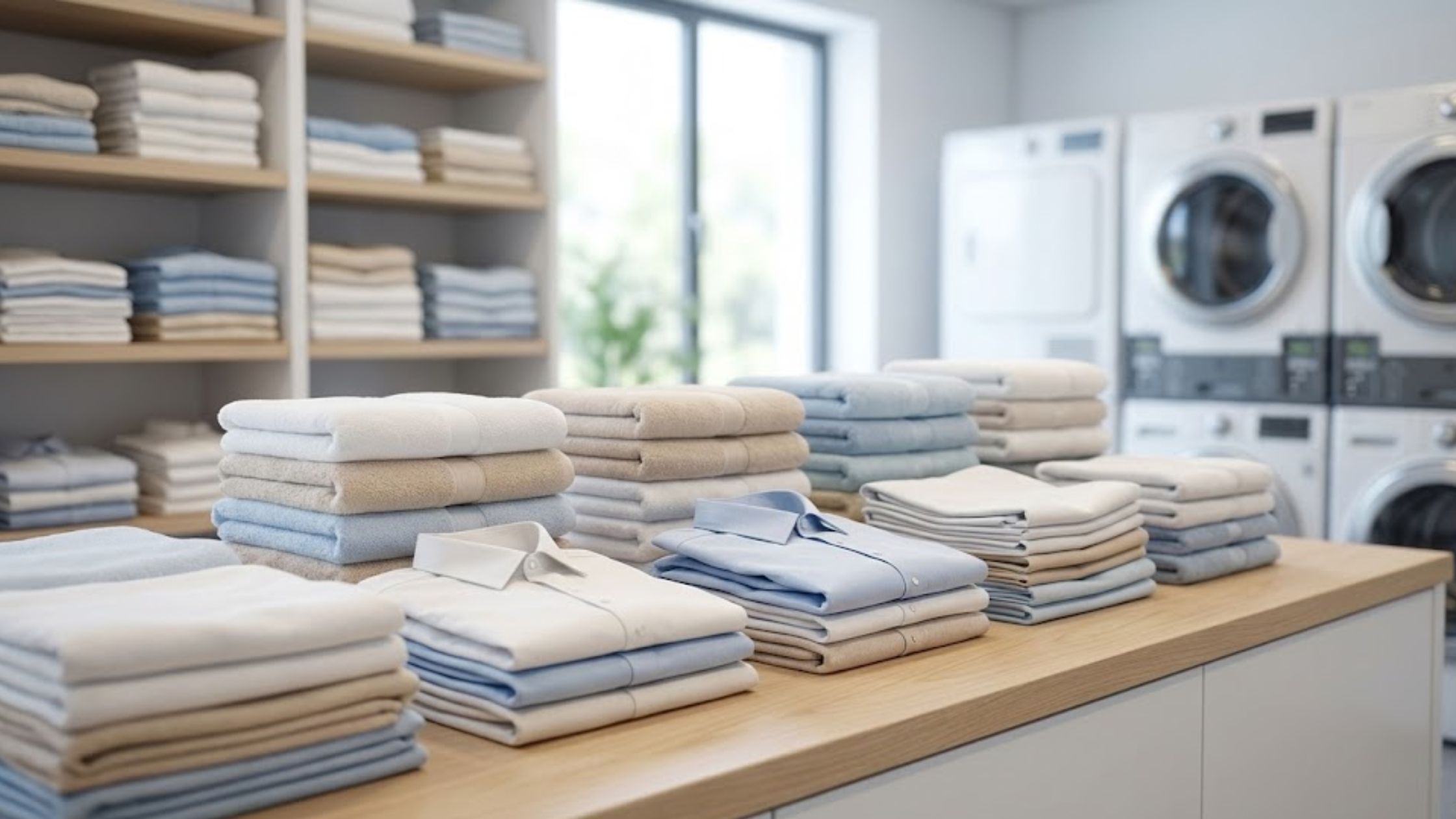You’re getting dressed for the day, and your shirt won’t stop clinging. If you’ve been wondering how to get rid of static cling in clothes, you’re not alone. That annoying cling happens when fabrics rub together and build up an electrical charge, especially in dry air. It’s not just uncomfortable; it can attract dust, make your outfit look wrinkled, and even cause small shocks. Luckily, you can stop it in seconds and prevent it from coming back. Whether you’re tackling laundry at home or using a trusted washing service in Manville, RI, lightly misting clothes with water or anti-static spray, rubbing them with a dryer sheet, or touching them with a metal hanger can release the charge and stop the cling instantly.
In this blog, we’ll walk you through quick fixes, smart prevention methods to help you keep every outfit smooth, soft, and static-free year-round.
What Is the Quickest Way to Remove Static from Clothes?
The quickest way to remove static from clothes is to balance moisture and discharge the built-up charge. In dry regions like Rhode Island, lightly misting clothes with water, using a metal object to ground the fabric, or creating a quick burst of humidity can stop cling in seconds and restore comfort instantly.
Here’s how to remove static from clothes fast without rewashing or changing your outfit:
- Use a humid touch: Lightly dampen your hands or a soft cloth, then glide it over the fabric to release trapped static.
- Ground with metal: Run a metal hanger or key along the inside seam to neutralize the charge.
- Create quick humidity: Step briefly into a steamy bathroom or into the steam from a running shower to rehydrate the air and reduce cling.
Why Static Cling Happens and How to Prevent It Naturally?
Before we dive into quick fixes, let’s discuss why static cling happens. Static cling is produced from the triboelectric effect fabrics rub together and exchange electrons, and in dry air, those charges don’t just dissipate. In Rhode Island, winters are dry. That means fewer water molecules to carry the charge away. So your fleece, nylon, or polyester is more likely to turn into a mini battery.
Here is how to get rid of static cling naturally:
- Add controlled moisture (steam, wool balls, damp cloth)
- Reduce friction (separate fabrics, avoid overfilling)
- Discharge excess charge (metal objects, grounding, spray formulas)
- Manage environment (humidifier, avoid ultra-dry conditions)
Now let’s break it into actionable steps.
Step 1: Start in the Wash
The fight against static begins before you ever hit “dry.” The right wash choices set the foundation for cling-free clothes. Adding moisture, balancing pH, and separating fabrics prevent the buildup of electric charge later in the dryer. Start clean, and you’ll spend less time fighting static after.
- Use fabric softener wisely: It coats fibers, reducing friction and charge buildup, but skip it on athletic or flame-resistant fabrics.
- Add a vinegar rinse: One tablespoon of white vinegar in the rinse cycle helps neutralize static naturally and softens cotton.
- Sort smartly: Separate synthetics, such as polyester, from cotton and wool to avoid charge transfer between fabrics.
Step 2: Master Your Dryer Settings and Tools
This is where most static forms and where you can stop it for good. The key is controlled moisture, less friction, and shorter drying cycles. In regions like Manville, small tweaks to your dryer routine can make all the difference between clingy and comfortable.
- Use steam mode: A short mist cycle adds humidity and discharges trapped electricity to help remove static from clothes effectively.
- Pull clothes early: Stop the cycle while clothes are slightly damp; complete dryness creates the strongest static.
- Use wool dryer balls: Add three to six per load to separate layers, maintain airflow, and hold micro-moisture through drying.
Step 3: Fix Static While Wearing Clothes
When you’re already dressed and static strikes, you need quick, no-laundry fixes. The goal is to neutralize the charge instantly and restore comfort without damaging fabric. These fast methods work whether you’re at home or heading out the door.
- Mist lightly: Spray water or anti-static spray from about six inches away to rebalance fabric moisture.
- Ground with metal: Run a metal hanger or safety pin inside the hem metal safely releases the built-up charge.
- Add surface moisture: Apply a dab of lotion to your hands, then smooth it over clingy areas for instant relief and to get static out of clothes on the spot.
Step 4: Adjust Your Home and Environment
Sometimes static isn’t a laundry issue; it’s an air issue. Dry indoor environments make it easy for fabrics to become electrically charged. By managing humidity and airflow, you’ll drastically reduce static buildup year-round and extend fabric life.
- Use a humidifier: Keep indoor humidity around 40-50% to prevent fabrics from drying out and sparking.
- Lower indoor heat: Overheating your home strips moisture from the air and worsens static.
- Choose better fabrics: Favor cotton, wool, or bamboo blends; synthetics like nylon and fleece attract the most static.
What Home Remedies Actually Work for Static Cling?
You don’t need commercial sprays to remove static; simple household remedies can fix it instantly. The key to removing static from clothes is moisture and grounding: restore humidity, neutralize charge, and reduce friction between fabrics. In Manville, where winter air amplifies static, these quick and long-term fixes will help keep every outfit cling-free and comfortable.
Here’s what works best according to the washing service in Manville, RI:
Instant Home Fixes
- Dampen lightly: Spray water onto the fabric or glide a damp cloth over it. The added moisture balances the charge instantly without soaking the fibers.
- Use a dryer sheet or foil: Rub a dryer sheet or a ball of aluminum foil over the garment to neutralize the static field.
- Ground with metal: Run a metal hanger or pin along the seams to safely discharge electricity through conduction.
- Moisturize your skin: Apply a small amount of lotion to your hands and smooth the clingy fabric. Hydration breaks the static connection between skin and cloth.
- Steam it quickly: Step into a bathroom with a hot shower running for a minute, the ambient humidity releases static instantly without re-washing.
Preventive Natural Remedies
- Add vinegar to the rinse: Half a cup of white vinegar softens fibers and balances pH, reducing static in the long term, especially effective for cotton blends.
- Try baking soda: A quarter cup in the wash cycle naturally relaxes fibers and prevents charge buildup.
- Boost home humidity: Use a humidifier or keep houseplants near heat vents, ideal for Rhode Island’s dry indoor air.
- Use wool dryer balls: Reusable and chemical-free, they lift fabrics and retain just enough moisture to naturally prevent static.
Why These Home Remedies Work?
Static cling occurs when the air is dry and fabrics rub together: electrons stick. Moisture makes the air conductive, letting that charge escape. Metal, steam, and mild acids (like vinegar) all help redistribute or neutralize those electrons. You don’t have to guess which hack to use or risk damaging delicate fabrics. From static-free finishes to professional stain removal, Laundry Lady in Manville, RI, handles every detail so your clothes come back fresh, soft, and ready to wear
Why Choose Laundry Lady for Static-Free Laundry?
Now that you know what really causes static and how to fix it at home, let’s talk about an easier solution: never dealing with it in the first place. Static builds when laundry is over-dried, fabrics are mixed incorrectly, or humidity is ignored. Most people don’t have time to fine-tune every wash and dry cycle, and that’s where Laundry Lady steps in.
We eliminate static before it starts by combining expertise, precision, and the right technology, giving your clothes a fresh, soft, and cling-free finish every single time.
- Tailored Drying Cycles: We monitor humidity and stop the load before it over-dries, keeping fabrics soft and static-free.
- Smart Fabric Sorting: Synthetics and cottons are processed separately with custom steam finishes to prevent friction buildup.
- Finishing Touches: Each garment is lightly steamed and handled with care so it returns ready to wear, no cling, no hassle.
Final thoughts
If you’ve been searching for how to get rid of static cling clothes, the answer is simpler than you think: moisture, balance, and smart laundry habits. By separating fabrics, adjusting dryer settings, and using natural remedies like vinegar or wool dryer balls, you can eliminate cling for good. And if you’d rather have someone handle it perfectly every time, Laundry Lady is here to help. Our team customizes each wash and dry cycle to prevent static before it starts, so your clothes come back soft, fresh, and ready to wear.
For laundry that looks, feels, and smells fresh without the frustration of static. Call Laundry Lady today at +401-429-6341.
Frequently Asked Questions (FAQs)
1. How do I get rid of static cling in clothes quickly?
Use a fine mist of water or anti-static spray, rub a dryer sheet or a metal hanger over the fabric, or step briefly into a steamy room. These instant methods neutralize the charge on dry clothes without needing a full wash.
2. What’s the best way to remove static from clothes without having to rewash?
Lightly mist the garment, use a metal object like a hanger to discharge the static, or rub with a dryer sheet. These fixes work when you need a quick solution while wearing it, without having to send it back to the laundry.
3. Why does static cling build up more in winter?
When indoor air is very dry (common in cold climates or when heat is running), fabric fibers lose moisture and become more prone to static. Lower humidity means fewer molecules to carry away charge, so fabrics cling more easily in winter.
4. Can vinegar reduce static in laundry?
Yes, adding ~½ cup white vinegar to the rinse cycle helps neutralize static by relaxing fibers and balancing electrical charge. It’s a simple, natural trick many use to reduce cling, especially in cotton blends.
5. Does rubbing aluminum foil on clothes help static cling?
It can. Crumpled aluminum foil acts as a conductor, allowing built-up static electrons to transfer away from fabrics. Toss foil balls in the dryer or swipe foil over fabric surfaces for a low-cost static fix.
6. How does Laundry Lady’s service prevent static in your clothes?
We use controlled drying (stop before “bone dry”), separate synthetic and natural fabrics, and apply steam or vapor finishing. That way, your clothes come back from the Laundry Lady already optimized against static. Call +401-429-6341.




